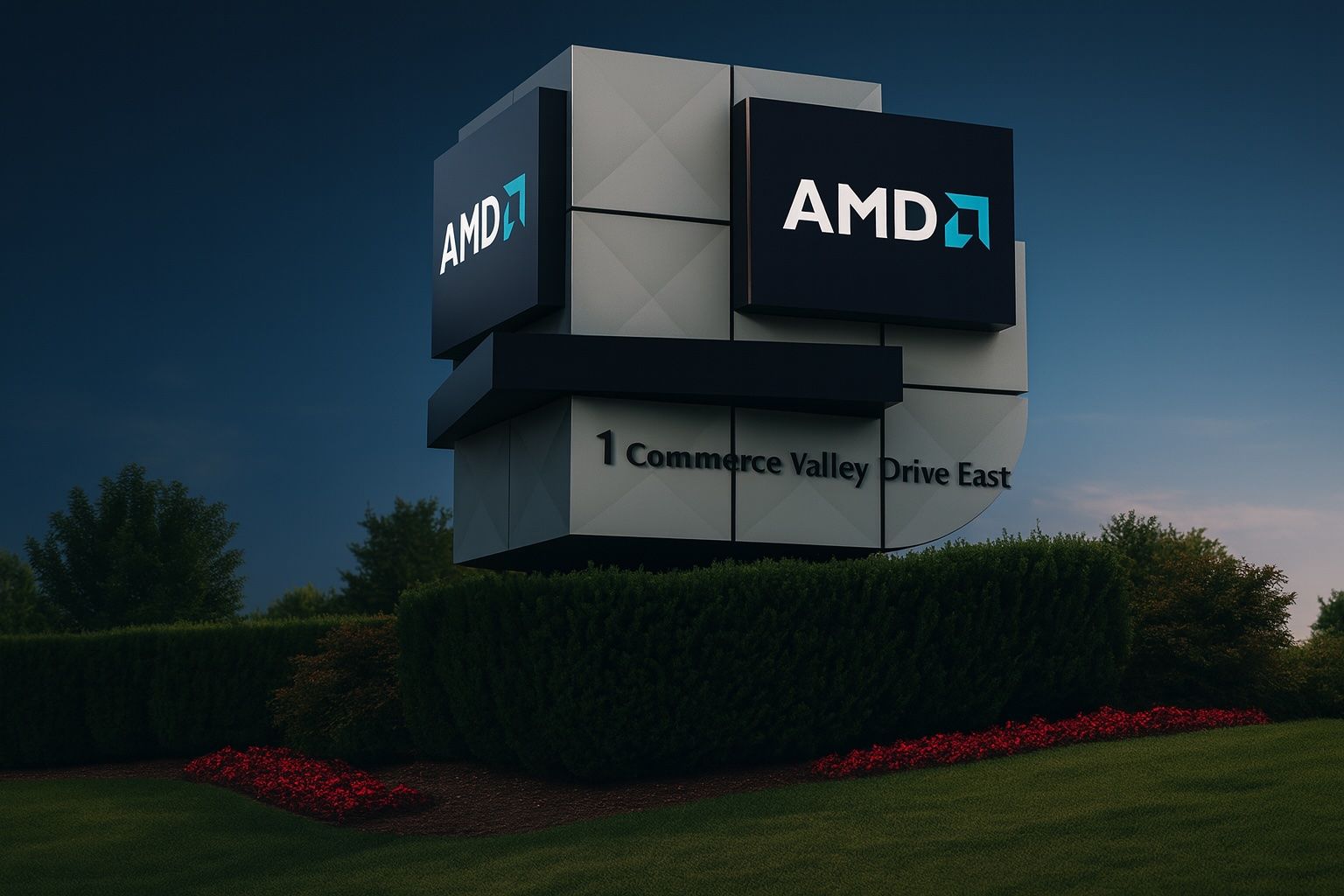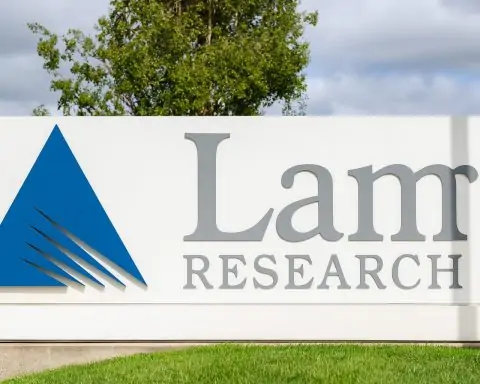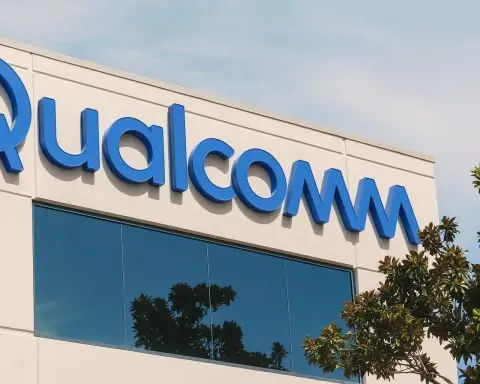- Surging Share Price: AMD’s stock has soared in 2025 – up nearly 93% year-to-date – with shares recently hitting a new 52-week high around $233 [1] after a blockbuster AI partnership sent the stock jumping over 40% in early October alone.
- AI OpenAI Partnership: On October 6, AMD unveiled a landmark multi-year deal to supply 6 gigawattsworth of cutting-edge AI chips to ChatGPT-maker OpenAI, a pact that could generate “tens of billions” in annual revenue [2]. OpenAI in return gets warrants for up to 160 million AMD shares (≈10%) at $0.01 each – vesting in tranches as chips are delivered and even requiring AMD’s stock to reach $600 for the final portion [3]. Executives call the deal “transformative…for the industry” [4].
- Latest Financials: Q2 2025 saw revenue jump ~32% year-on-year (to ~$7.7 billion) on booming demand for server CPUs and initial AI accelerator sales [5]. Gross margins, however, slid about 10 percentage points to ~43% amid heavy R&D investments and a hefty $800 million inventory charge for new AI chips [6]. AMD still issued bullish guidance for Q3 – targeting ~$8.7 billion in revenue (≈21% YoY growth) [7] – and analysts expect full-year 2025 sales of $32–33 billion (up from $23.6 billion in 2024) [8].
- Wall Street’s View: Analysts are broadly bullish on AMD’s prospects in AI and data-center markets. Many have hiked price targets after the OpenAI deal – e.g. Jefferies upgraded AMD to “Buy” with a Street-high $300target [9], while others like Northland, UBS, and Rosenblatt have raised targets into the $190–$250 range [10]. However, valuation concerns linger: at ~90× earnings, bears warn AMD is “overvalued”without flawless execution [11]. Cautious voices (e.g. Goldman Sachs at ~$140 target) argue Nvidia still dominates AI and that AMD’s lofty stock already prices in a very rosy scenario [12] [13].
- Rivals & Market Position: AMD now stands as the world’s third-largest chipmaker (~$300B+ market cap), yet remains a fraction of Nvidia – which commands ~94% of the AI GPU market [14] and recently reached an almost $4 trillion valuation amid the AI boom [15]. Intel, AMD’s longtime CPU rival, has seen a government-backed revival (a ~$9 billion U.S. stake for ~10% of Intel) and even a $5 billion Nvidia investment [16], fueling its turnaround efforts. Still, AMD continues eroding Intel’s market share (now >25% in server CPUs) [17] and is positioning as a credible No.2 alternative to Nvidia in accelerators – with new GPUs and an “open” ecosystem strategy aimed at challenging the leaders in coming years [18] [19].
AMD’s headquarters sign in Silicon Valley. The company’s stock has surged amid blockbuster AI deals and strong chip demand in 2025.
Stock Performance & Recent Rally
Advanced Micro Devices (AMD) has been one of 2025’s top semiconductor stocks, staging a dramatic rally after a volatile 2024. As of early October, AMD shares traded around $230+ – nearly double their level at the start of the year [20]. The stock had already climbed ~30% year-to-date by late September [21] [22], outperforming both the S&P 500 and the Philly Semiconductor Index. Then came an explosive surge in October: AMD’s stock leapt about 29% in a matter of days, topping $213 by Oct. 7 [23], and continued to rally into Oct. 8 with a further ~10% intraday jump [24]. In fact, across the first three sessions of October, AMD notched its best three-day run in years, driven by a wave of AI-fueled optimism.
What’s behind this historic rally? In large part, investor excitement over AI (artificial intelligence). AMD’s market value had already been buoyed through 2025 by the frenzy for AI-related chips – a trend that lifted many chip stocks. But a game-changing announcement on Oct. 6 provided a fresh catalyst (see next section). Within days, AMD’s share price skyrocketed from the mid-$160s to the $220+ range, blowing past Wall Street’s previous average price target (~$152) [25]. Trading volume spiked as well, suggesting both institutional and retail buyers piled in, fearing to miss out on “the next big AI winner.” Some analysts described the rally as “FOMO”-driven, with enthusiasm sometimes outpacing fundamentals [26]. Even so, the stock’s momentum has been undeniable – by Oct. 8, AMD had gained ~93% in 2025 (versus ~12% for the broader chip index) [27] [28], and its market capitalization swelled to around $340+ billion [29].
It’s worth noting that AMD’s run-up follows a difficult 2024 in which the stock fell about 18% [30]. The subsequent rebound in 2025 reflects both sector-wide tailwinds – an AI investment boom that has benefited nearly all chipmakers – and company-specific wins. Investors have been encouraged by AMD’s continued gains in the processor market (taking share from Intel) and its emergence as a player in AI accelerators. However, the recent valuation is demanding: even after the early-October dip from its absolute highs, AMD trades around 56× forward earnings and ~94× trailing P/E, a rich multiple that “leaves little room for error” going forward [31]. For context, Nvidia’s P/E (~50×) looks modest by comparison – reflecting Nvidia’s far larger current profits [32]. In short, investors have given AMD a growth-stock premium, betting on significant future earnings expansion. Whether AMD can deliver on those high expectations will determine if the stock’s rally is sustainable or if a pullback looms after the initial euphoria.
OpenAI Deal Fuels Latest Surge
The catalyst for AMD’s early October spike was a blockbuster partnership with OpenAI, the AI research firm behind ChatGPT. Announced on October 6, the deal is one of the most significant in AMD’s history – and a direct challenge to Nvidia’s dominance in AI chips. Under the multi-year agreement, AMD will supply OpenAI with hundreds of thousands of GPU accelerators (including forthcoming Instinct MI450 chips) to help power OpenAI’s next-generation AI infrastructure [33] [34]. OpenAI plans to deploy up to 6 GW (gigawatts) of AMD-based compute capacityacross multiple data centers – roughly equivalent to equipping several massive AI supercomputer clusters [35] [36]. Initial shipments (for a 1 GW cluster) will start in late 2026 with AMD’s MI450 GPUs [37]. For AMD, this represents a huge revenue opportunity: executives forecast the OpenAI contract could eventually bring in over $100 billion spread across four years [38], translating to “tens of billions per year” once fully ramped. For perspective, AMD’s total revenue in 2024 was under $25 billion, so this single deal has the potential to quadruple AMD’s business in the coming years if all goes to plan [39].
In exchange, OpenAI secured an eye-popping equity incentive. AMD granted OpenAI a warrant to purchase up to 160 million AMD shares (approximately 10% of the company) at a token price of $0.01 each [40]. These shares vest in tranches as key milestones are met – both technical milestones (like OpenAI successfully deploying the GPUs) and stock price milestones. Notably, the final tranche requires AMD’s stock to hit $600 per share (nearly 4× the pre-deal price) for OpenAI to fully realize the stake [41]. In essence, OpenAI only gets that 10% ownership if it helps AMD achieve transformational success (massive chip deployment and a moonshot stock price). AMD’s Data Center EVP Forrest Norrod called the alliance “certainly transformative, not just for AMD, but for the dynamics of the industry” [42]. OpenAI’s CEO Sam Altman likewise hailed it as “a major step in building the compute capacity needed to realize AI’s full potential”, saying AMD’s chips will “accelerate progress” in AI for everyone [43]. The symbolism is huge: one of the world’s leading AI labs is effectively betting on AMD as a critical supplier, at a time when Nvidia has a near-monopoly on high-end AI processors.
Market reaction to the OpenAI deal was immediate and dramatic. AMD’s stock jumped roughly 23% in pre-market trading on Oct. 6 after the news broke [44], and it closed that day up about 3% in regular trading while rival Nvidia’s stock dipped [45]. The rally then accelerated over the next two sessions (Oct. 7–8) as investors digested the implications. This was a sharp about-face from just days earlier – when rumors that OpenAI might develop its own chips (or partner with Broadcom) had sent AMD’s stock down ~5.5% on nervous speculation [46]. Securing OpenAI’s massive order flipped the narrative overnight. It instantly positioned AMD as a truly credible contender in AI hardware, whereas before it was often seen as an also-ran to Nvidia. One analyst noted that OpenAI’s sky-high valuation (~$500 billion in private markets) and aggressive AI buildout have been “lifting all AI chip stocks” lately – and now “AMD has one of the premier seats at the table” [47]. The deal not only guarantees a major future revenue stream (starting in 2026) but also bolsters AMD’s credibility in an arena that will define the next era of computing.
Wall Street analysts were quick to respond with upgrades and bullish commentary. Jefferies raised its rating to Buy and set a Street-high $300 price target, citing the OpenAI partnership as a thesis-changing win [48] [49]. Barclays similarly upped its target to $300 and called AMD’s trajectory “potentially positive” given the OpenAI upside [50]. Multiple banks – from Morgan Stanley to Wells Fargo – boosted their forecasts for AMD following the news [51]. Even Stifel, which already had a bullish outlook, issued a note highlighting that AMD’s new deals (like OpenAI and others) could warrant significant upside and bring in substantial additional revenue (and potentially up to 160 million new shares via the warrant) if performance targets are met [52]. “We see this as a game-changer that validates AMD’s AI road-map,” one analyst told Reuters, emphasizing that having OpenAI as a marquee customer should attract other cloud providers to consider AMD’s GPUs [53] [54]. The consensus was that Nvidia’s dominance in AI will no longer go unchallenged – there’s now a viable No.2 supplier in town, backed by one of AI’s biggest end-users.
Of course, challenges remain. The OpenAI order is forward-looking – the bulk of the revenue won’t materialize until 2026–2027, since AMD’s MI450 chips need to be developed, manufactured, and delivered at scale. That means AMD must execute flawlessly on an ambitious product roadmap to meet its commitments. Any delays in chip development or production could jeopardize the deal’s full value. Additionally, OpenAI is not exclusive to AMD; in fact, just a few weeks prior, Nvidia announced its own $100 billion arrangement to continue supplying OpenAI with next-gen “Vera Rubin” GPU systems through 2026 [55]. OpenAI has made it clear it will dual-source hardware – relying on both Nvidia andAMD (and even exploring custom silicon with others) to satisfy insatiable AI compute demand [56] [57]. In Altman’s words, the AMD partnership is “in addition to our collaboration with Nvidia”, not a replacement [58]. This underscores that Nvidia won’t cede ground easily. Nonetheless, scoring a central role in OpenAI’s plans is a huge validation for AMD’s technology. It has turned AMD into the underdog-turned-contender in AI chips – a narrative that clearly energized investors and contributed heavily to the recent stock surge.
Recent Financial Results & Outlook
AMD’s latest financial results show a company growing briskly again after a soft patch, but also spending heavily to seize its moment. In Q2 2025, the most recent reported quarter (April–June), AMD’s revenue was $7.7 billion, up 32%year-over-year [59] [60]. This marked a sharp rebound from 2024, when sales had stagnated. The growth was driven by two main areas: data center chips and client (PC) processors. In fact, AMD notched record sales of its EPYC server CPUs in Q2, as cloud giants and enterprises snapped up high-performance chips for their expanding infrastructure [61]. Data Center segment revenue rose about 14% YoY to $3.2 B, despite some headwinds from U.S. export restrictions on certain MI300-series AI GPUs to China [62]. Meanwhile, the Client and Gaming segment (which includes PC CPUs and gaming GPUs) surged 69% YoY to $3.6 B [63] – a remarkable jump attributed to strong Ryzen processor demand and a rebound in the PC market, as well as semi-custom chips for gaming consoles. After a PC slump in 2022–23, AMD appears to be riding a refresh cycle with new Ryzen launches, regaining share as consumers and businesses upgrade to newer hardware [64] [65].
However, profitability has been a mixed picture. AMD’s aggressive investments in new products (and some one-time charges) have pressured margins in the near term. In Q2, non-GAAP gross margin slipped to ~43%, down from ~53% a year earlier [66]. The company revealed that an $800 million inventory write-down – largely related to its MI300 AI chips and export-controlled inventory for China – shaved about 10 percentage points off gross margin [67]. Essentially, AMD had built up stock of advanced GPUs that it couldn’t ship to China due to new U.S. rules, forcing a charge. Even aside from that, AMD has been pouring resources into R&D for next-gen CPUs and GPUs, plus building up inventory in anticipation of AI chip launches. “We are prioritizing growth over short-term profit,” CFO Jean Hu noted, emphasizing that ramping production of advanced 5nm and 4nm chips comes with upfront costs but will be “highly accretive” to earnings long-term [68]. Operating expenses have climbed as AMD integrates past acquisitions (like Xilinx and Pensando) and hires talent (including small AI software startups) to strengthen its software ecosystem [69]. As a result, Q2 net income and EPS fell despite the revenue jump – non-GAAP net income was down ~31% YoY to $781 million, and EPS came in at $0.48 (down 30%) [70] [71]. These declines were anticipated given the strategic spending, but they highlight that AMD’s current profits are modest relative to its valuation.
Importantly, AMD’s forward guidance has signaled confidence in a strong second half of 2025. When reporting Q2 (in early August), the company guided Q3 2025 revenue to approximately $8.7 billion (±$300 M) [72]. That forecast was ahead of analysts’ expectations at the time and implied ~21% year-over-year growth at the midpoint – an acceleration from Q2’s 13% sequential uptick [73]. Notably, AMD said this outlook excludes any potential sales to China of high-end MI300 GPUs, given uncertainty around export licenses [74]. In other words, the growth is being driven by demand in other regions (North America, Europe, etc.) and by other products, such as data center CPUs and new AI deployments in permitted markets. The company expects a significant ramp in Instinct MI350 series accelerator shipments in H2 2025 (these are upgraded AI chips following MI300) and continued EPYC CPU traction, which should lift both revenue and gross margin from the Q2 levels. CEO Dr. Lisa Su stated, “We are seeing robust demand across our computing and AI product portfolio and are well positioned to deliver significant growth in the second half of the year” [75].
Wall Street analysts currently project full-year 2025 revenue around $32–33 billion [76], which would be roughly 35–40% growth over 2024’s $23.6 B total – an impressive rebound. That estimate was before factoring any contribution from the new OpenAI deal (since those shipments start later on). If AMD continues executing, 2025 could mark a new high-water mark for sales. Profit-wise, consensus is that earnings per share will improve in 2025, but not as dramatically as revenue, due to all the upfront investments and likely competitive pricing. Analysts see double-digit percentage sales growth again in 2026 [77] as the OpenAI contract and other wins (perhaps large cloud customers following OpenAI’s lead) kick in more materially. AMD’s upcoming Q3 2025 earnings report (due Nov. 4) will be closely watched for any updates on AI chip backlogs, data center momentum, and gross margin trends. Investors will also be eager to hear if management raises its outlook or provides more color on how the OpenAI partnership might shape 2026 guidance. In short, AMD’s financial trend is positive – rapid top-line growth with temporarily constrained margins – reflecting a company trying to capture a once-in-a-generation opportunity in AI, even if it means taking some lumps in near-term profitability.
Competitive Landscape: AMD vs. Nvidia vs. Intel
AMD’s rise has come at the intersection of two long-running battles – one with Intel in CPUs and one with Nvidia in GPUs – now converging under the AI spotlight. The current landscape is that of a fierce three-way fight among chip heavyweights, each with different strengths:
- Against Nvidia (AI Accelerators & GPUs): By most measures, Nvidia is still far ahead in the AI chip race. The company’s GPUs dominate about 94% of the market for graphics processors and AI accelerators [78]. Nvidia has ridden the AI boom to record-smashing financials and at one point in 2025 reached an almost $4 trillion market capitalization – briefly making it the world’s most valuable company [79]. Its current flagship AI chip, the H100, is considered the gold standard for training large AI models, and Nvidia’s software platform (CUDA) remains the industry default. However, AMD is no longer a non-factor in this space. With its Instinct line of data center GPUs, AMD is starting to make a dent. The latest GPU, MI300X, launched in late 2023, has been deployed by major players including Microsoft, Meta, Oracle, Dell and others for AI workloads [80]. In certain AI inference tasks, AMD’s MI300X has even been shown to beat Nvidia’s H100 on performance [81] – a proof point that AMD’s architecture can compete at the high end. AMD is also pursuing a strategy of open ecosystems to differentiate itself. Its ROCm software stack is open-source (whereas Nvidia’s CUDA is proprietary), and AMD is designing forthcoming “Helios” AI supercomputing systems that use standard, open interconnects (like Ethernet) instead of Nvidia’s closed NVLink fabric [82] [83]. This openness could appeal to some customers who want to avoid vendor lock-in or mix-and-match AI hardware from different suppliers [84]. As CEO Lisa Su put it, “The future of AI is not going to be built by any one company or in a closed ecosystem” [85] – a not-so-subtle jab at Nvidia. Looking ahead, AMD has ambitious GPU roadmaps: it plans to launch the Instinct MI400 series in 2026, aiming to roughly match Nvidia’s next-gen chips in performance [86]. It’s also building full GPU-based supercomputers (Helios racks with 72 AMD GPUs each) to compete with Nvidia’s DGX “AI superpods” solutions [87]. While AMD remains a distant #2 in AI accelerators for now, the sheer pace of AI demand means there is room for a credible second source. If AMD can execute on these plans and leverage partnerships like the OpenAI deal, it could evolve from merely a “backup option” to a true alternative leader in AI chips over the next couple of years [88].
- Against Intel (CPUs & Chip Manufacturing): AMD’s rivalry with Intel goes back decades in the CPU arena – and in recent years AMD has been steadily chipping away at Intel’s dominance. Thanks to its Zen architecture and use of cutting-edge foundry technology (TSMC’s 7nm/5nm nodes), AMD has often had an edge in performance and efficiency versus Intel’s processors. As a result, AMD’s market share in CPUs has climbed almost every quarter; in the crucial server CPU segment, AMD’s EPYC line now accounts for well above 25% of shipments [89], up from effectively 0% five years ago. Intel, however, is not standing still. Under CEO Pat Gelsinger, Intel has embarked on a massive turnaround plan, including a strategy to regain process technology leadership by 2025–2026 and to revamp its product lineup. Intel received a ~$9 billion capital infusion from the U.S. government (taking a ~10% stake as part of the CHIPS Act) in 2025 [90]. In a surprising twist, Nvidia also invested $5 billion in Intel in September 2025 [91] – a vote of confidence that sent Intel’s stock soaring 23% in one day [92] [93]. These moves have given Intel the resources to speed up development of its new process nodes (Intel 18A, 20A, etc.), and to launch upcoming CPU families (like Panther Lake and Arrow Lake) that aim to be far more competitive with AMD. Intel’s stock has rallied nearly 50% year-to-date (from a very low base) on optimism about this rebound [94] [95]. For now, AMD continues to enjoy a performance lead in many segments and the momentum of being the “disruptor” taking share. But Intel is a wildcard – if Gelsinger’s roadmap delivers, by 2026 Intel could narrow the gap or even leapfrog in certain metrics [96]. Intriguingly, the boundaries between these rivals are also blurring: in an unusual alliance, AMD has been in talks to use Intel’s foundry services to manufacture some chips [97]. With the global crunch in chip fab capacity, AMD is evaluating Intel’s process technology to potentially diversify beyond its reliance on TSMC [98]. If Intel’s factories can meet AMD’s cost and performance needs, we may see Intel actually producing chips for AMD in a couple years – a scenario once unimaginable, highlighting how industry dynamics are shifting toward pragmatism and “coopetition.” Both companies also face common threats from Apple (which now designs its own ARM-based Mac chips, cutting out Intel/AMD) and from a new wave of startups designing custom AI chips. So the competitive chessboard is very complex. In summary, AMD is positioned as a nimble contender flanked by two giants. As one tech analyst quipped about AI chips, “It’s Nvidia’s world, with everybody else paying rent.” [99] But many in the industry are rooting for AMD’s continued rise, since a more competitive landscape is seen as good for innovation and customers. The next 1–2 years will be critical – if AMD’s bets pay off (in both CPUs and GPUs), it could emerge as a more equal three-way competitor; if not, it risks remaining a distant second or third player in the most important markets [100].
Analyst Commentary & Stock Price Forecasts
Wall Street analysts have been intensely debating AMD’s valuation and upside, especially in light of its recent rally and AI prospects. Overall, sentiment tilts positive – AMD carries a consensus rating around “Buy/Outperform”, with a large majority of analysts recommending it. According to data from late September, about 28 of 44 analysts covering AMD rated it a Buy (or equivalent) [101]. This bullish cohort argues that AMD is a prime beneficiary of the AI revolution and of the ongoing shift away from Intel’s dominance in CPUs [102]. The bull case is that AMD’s growth spurt is just beginning: the company is expanding in multiple areas (PC, data center, AI, embedded) and could see an inflection in earnings as its new products gain traction. For instance, HSBC’s semiconductor analyst in July raised his AMD price target to $200 and upgraded to Buy, citing much stronger AI chip demand than previously expected [103]. He noted that feedback from early customers on AMD’s MI300X GPUs was “a lot more positive” than before, and he projected AMD’s AI-related revenues could exceed $8 billion in 2025 (versus consensus estimates around $6B) [104]. Another bullish argument is that AMD’s data center business (which includes server CPUs, adaptive chips from Xilinx, and GPUs) is undervalued relative to its potential. “Stop comparing AMD’s chips with Nvidia’s and look at its data-center growth,”one commentary urged [105] – pointing out that AMD is growing its server CPU sales robustly and that its broader portfolio (CPUs + GPUs + FPGAs) gives it multiple engines for growth beyond just AI accelerators [106]. Reflecting this optimism, numerous banks have lifted price targets in recent months: UBS bumped its 12-month target from $150 to $210 after strong PC and server trends [107]; Northland Capital went from $132 to $198 on AMD’s AI updates [108]; Bank of America, Wells Fargo, and others have also issued upbeat notes. Until early October, the highest Street price target had been around ~$220 [109] – but that ceiling quickly moved higher with the OpenAI deal news (Jefferies and Barclays at $300, Rosenblatt and Roth Capital at $250 etc. [110] [111]). It’s clear that many analysts see significant headroom for AMD’s stock if it executes well in AI and continues taking share in its core markets.
On the other hand, the bearish or cautious perspective is far from extinct. Skeptics point to AMD’s stretched valuationand the competitive risks. At around 90× trailing earnings (and ~56× forward) [112], AMD’s stock is baking in a lot of future success. Bears argue the stock may have “run ahead of fundamentals”, especially after the recent spike [113] [114]. A contributor on Seeking Alpha bluntly rated AMD a Sell in October, contending that after the sharp rally, the upside is limited and that any stumble could trigger a big pullback [115]. The core bear case is that AMD’s current earnings power doesn’t justify the market cap – meaning the company must achieve exceptional growth and flawless execution to grow into its valuation [116] [117]. They note that Nvidia’s entrenched lead (both in hardware performance and its CUDA software ecosystem) won’t be easy to overcome; one strong quarter of GPU sales by AMD doesn’t guarantee a long-term trend. Additionally, AMD might face margin pressures in the AI chip business – to win major deals (like OpenAI), AMD could be pricing its GPUs more aggressively than Nvidia, which could limit profitability even as revenue grows [118]. The potential for an Intel comeback in CPUs is also a risk by 2025–26, which could slow AMD’s PC/server share gains if Intel’s new chips impress [119]. Then there are macro concerns: the semiconductor cycle can be volatile, and some worry that the current AI hype could cool if, for example, corporate spending on AI proves less explosive than anticipated or if higher interest rates dampen tech investment [120]. Big tech frenzies have faltered before (some draw parallels to the dot-com bubble), and a few voices wonder if AI chips are in a mini-bubble. Goldman Sachs has taken a more cautious stance on AMD with a Neutral rating and a ~$140 price target, citing uncertainty about how much of the burgeoning AI demand AMD will actually capture from incumbents like Nvidia [121] [122]. Essentially, the bears say AMD’s stock already discounts a rosy scenario, leaving little margin for error.
The divergence in price targets reflects these views. As noted, the highest targets now extend to $250–300 (implying analysts who envision substantial further upside if AI bets pay off) [123] [124]. Meanwhile, the low-end targets (e.g. ~$120–$150) come from those focusing on valuation and competitive uncertainties. AMD’s own execution in the coming quarters will likely determine which camp is proven right. For now, public market sentiment seems to be giving AMD the benefit of the doubt – the stock’s momentum suggests investors are leaning bullish, encouraged by the company’s technology trajectory and strategic wins. But as always, AMD will need to deliver results (growing earnings, hitting product launch timelines, etc.) to support its stock price. Any slip-ups or delays – say, a problem with the upcoming Zen 5 CPUs, RDNA 4 GPUs, or MI300/MI350/MI400 accelerators – could renew volatility in the share price [125]. Conversely, if AMD continues exceeding expectations and capitalizing on opportunities (like the OpenAI deal’s “halo effect” attracting more business), some analysts argue that today’s valuation will look justified in hindsight, or even low, once AMD’s earnings catch up to its potential [126]. In short, AMD is a battleground stock at the moment – with huge optimism tempered by warnings of caution – making it one of the most closely watched names in the market.
Technology Developments & Product Catalysts
Underpinning AMD’s stock story are the major technology developments and product releases that the company has been rolling out (or planning) to fuel its growth. CEO Lisa Su often says AMD is in a “high-performance computing”race on multiple fronts – and indeed 2025 has seen AMD doubling down on new chips across its portfolio:
- CPU Advances (Zen 4 and Zen 5): AMD’s Zen microarchitecture has been the key to its comeback in processors. The current generation, Zen 4, powers the Ryzen 7000 series CPUs and EPYC “Genoa”/“Bergamo” server chips, delivering leadership in many multi-threaded and energy-efficiency benchmarks. In late 2024 and into 2025, AMD has been launching upgraded models (like higher core-count EPYC variants and refreshed desktop CPUs) that keep pressure on Intel’s lineup. The next generation, Zen 5, is highly anticipated – chips based on Zen 5 are expected to debut in late 2025, fabricated on an advanced 4nm/3nm process. Zen 5 is projected to bring significant IPC (instructions per clock) gains, new AI acceleration features, and other improvements. AMD’s roadmap suggests Zen 5 will form the basis of “Turin” EPYC processors for servers and Ryzen 8000 series for client PCs. These products are crucial because they will determine if AMD can extend its lead over Intel or at least stay ahead while Intel tries to execute its own new architectures. If Zen 5 delivers the performance leaps analysts expect, it could further cement AMD’s position in data centers and high-end PCs – which in turn supports the bullish case for AMD’s stock. Conversely, any delay or underwhelming Zen 5 launch could give Intel an opening, reinforcing why flawless execution is needed.
- GPU & AI Chip Roadmap: On the graphics side, AMD’s Radeon division introduced the RDNA 3 GPU architecture (Radeon RX 7000 series) in late 2022/2023, and the next-gen RDNA 4 is likely slated for 2024–2025. While in gaming GPUs AMD is competitive (offering good price/performance and efficiency), the bigger strategic focus is on datacenter GPUs for AI. AMD’s Instinct MI300 family – particularly the MI300A (APU) and MI300X (GPU) – launched in 2023 as AMD’s answer to Nvidia’s A100/H100. The MI300X is a pure GPU with 192 GB of HBM memory, tailored for large AI models. Initial reports and customer trials (with companies like Meta and Oracle) suggest the MI300X is viable for AI training and inference, which is a huge step forward for AMD. Through 2024, AMD has been ramping production of MI300 and prepping a follow-on MI350 series(sometimes referred to as MI355X for certain variants) [127] [128]. These accelerators likely feature tweaks and higher performance to better compete with Nvidia’s H100. Indeed, AMD stated that feedback from early MI300 deployments has improved markedly, indicating the hardware and its ROCm software stack have matured [129]. Looking further out, AMD’s MI400 generation (expected in 2025–26) is aimed at roughly leapfrogging to parity with Nvidia’s post-H100 chips [130]. This will coincide with AMD’s broader platform efforts like Project Helios – essentially AMD-designed supercomputers where many AMD GPUs work in tandem. Success in these endeavors could make AMD an increasingly compelling choice for cloud providers, enterprise AI labs, and even supercomputing centers that currently default to Nvidia. It’s these future AI product launches that investors are excited about, especially now that a marquee customer (OpenAI) is in hand. In the words of AMD’s CTO Mark Papermaster, the company is “all-in on AI”, aligning its CPU, GPU, and Adaptive (FPGA) products to tackle AI workloads across the cloud, edge, and endpoint.
- Adaptive and Custom Silicon: Through the 2020 acquisition of Xilinx, AMD gained a suite of adaptive chips like FPGAs (field-programmable gate arrays) and adaptive SoCs. This business (now the Adaptive & Embeddedsegment) has applications in 5G telecom, automotive, aerospace, and more. In 2025, AMD has been integrating Xilinx’s AI Engine (DPUs, SmartNICs, etc.) into its product lines. For example, AMD’s Versal and Alveo accelerators are being used in telecom 5G networks and AI edge deployments. While not as high-profile as GPUs, these adaptive chips strengthen AMD’s hand in diversified markets (and contributed roughly 20% of AMD’s revenues). Additionally, AMD has been open to semi-custom projects – tailoring chips for specific large customers. It famously supplies the CPUs/GPUs for Sony’s PlayStation and Microsoft’s Xbox consoles. Now, in the AI era, it wouldn’t be surprising if AMD engages in custom chip designs for big clients (similar to how Nvidia and Google sometimes do). AMD’s flexibility and broad IP portfolio could yield new partnerships beyond standard off-the-shelf chips.
- Manufacturing and Supply Chain: One external factor influencing AMD is its heavy reliance on TSMC in Taiwan to manufacture its chips. TSMC’s cutting-edge fabs (5nm, 4nm, soon 3nm) produce all of AMD’s most advanced products. In 2025, industry capacity at those nodes has been extremely tight (partly due to the surge in AI chip orders). AMD has had to carefully manage supply – it even explored using Intel’s foundry for additional capacity as noted earlier [131]. Ensuring enough supply of AI GPUs (so that it can actually fulfill deals like OpenAI’s) is crucial. AMD has indicated it is working closely with TSMC to secure more capacity, and if needed, will consider multi-sourcing. Any snafu in the supply chain (e.g. geopolitical tensions affecting TSMC, or delays in 3nm ramp) could impact AMD’s product timelines, which is another risk to watch. On the flip side, if AMD can navigate supply constraints and perhaps leverage Intel’s new foundry offerings in the future, it could alleviate one historical disadvantage (Intel’s in-house fab advantage).
All these technology efforts contribute to investor sentiment. In 2025, AMD has been showcasing its new products at events like CES and Computex – building hype that it’s on the forefront of high-performance computing and AI. The company’s long-term vision (often reiterated by Dr. Lisa Su) is that we’re entering an era of “heterogeneous computing” – where CPUs, GPUs, adaptive accelerators, and specialized engines all work together to power everything from data center AI to immersive gaming to intelligent edge devices. AMD uniquely plays in all those areas, which is something neither Intel nor Nvidia alone can claim (each has gaps in their portfolio). This has become part of the investment thesisfor AMD: that it can benefit from multiple technology mega-trends at once (AI, cloud, 5G, gaming, etc.). The OpenAI deal, for example, not only promises revenue but also likely pushes AMD to advance its software ecosystem (ROCm, AI libraries) and ensure tight integration of its chips into platforms like Microsoft Azure (given Microsoft’s stake in OpenAI). Progress on the software side – making it easier for developers to adopt AMD GPUs – is another important factor that doesn’t make headlines but influences how successful AMD will be in courting AI customers.
In conclusion, AMD’s stock as of October 8, 2025 reflects a company at a pivotal moment. The shares have skyrocketed on excitement that AMD could emerge as a true leader in the AI hardware boom, not just a beneficiary on the margins. The partnership with OpenAI has added a new leg to the growth story, complementing AMD’s ongoing gains in CPUs and adaptive computing. Financially, AMD is demonstrating strong growth, though investors must remain patient on margins as the company invests for the future. The competitive environment is intense – facing an AI juggernaut in Nvidia and a resurgent old rival in Intel – but AMD has shown it can punch above its weight and even collaborate in unconventional ways to get ahead. With CEO Lisa Su’s turnaround of AMD (from near-bankruptcy a decade ago to a $300+ billion tech powerhouse) already hailed as “one of the most dramatic in tech” [132], the next chapters will determine just how far this once-scrappy underdog can go. As one financial outlet put it, the AI frenzy has made AMD a trending ticker and a symbol of the new tech boom [133]. Now, it’s up to AMD to justify the hype – by delivering on its ambitious roadmaps and continuing to innovate in a field that’s shaping up to define the future of computing. Investors and tech enthusiasts alike will be watching closely.
Sources: AMD investor reports; ts2.tech news and analysis [134] [135]; Reuters, Yahoo Finance and Insider coverage [136] [137]; industry analyst commentary [138] [139].
References
1. finviz.com, 2. ts2.tech, 3. ts2.tech, 4. ts2.tech, 5. ts2.tech, 6. futurumgroup.com, 7. leverageshares.com, 8. ts2.tech, 9. finviz.com, 10. watcher.guru, 11. ts2.tech, 12. ts2.tech, 13. ts2.tech, 14. ts2.tech, 15. ts2.tech, 16. ts2.tech, 17. ts2.tech, 18. ts2.tech, 19. ts2.tech, 20. finviz.com, 21. ts2.tech, 22. ts2.tech, 23. stockstotrade.com, 24. stockstotrade.com, 25. ts2.tech, 26. ts2.tech, 27. ts2.tech, 28. finviz.com, 29. watcher.guru, 30. ts2.tech, 31. ts2.tech, 32. ts2.tech, 33. ts2.tech, 34. ts2.tech, 35. ts2.tech, 36. ts2.tech, 37. ts2.tech, 38. ts2.tech, 39. ts2.tech, 40. ts2.tech, 41. ts2.tech, 42. ts2.tech, 43. ts2.tech, 44. the-decoder.com, 45. ts2.tech, 46. ts2.tech, 47. ts2.tech, 48. finviz.com, 49. finviz.com, 50. stockstotrade.com, 51. finviz.com, 52. stockstotrade.com, 53. ts2.tech, 54. ts2.tech, 55. ts2.tech, 56. ts2.tech, 57. the-decoder.com, 58. the-decoder.com, 59. ts2.tech, 60. futurumgroup.com, 61. futurumgroup.com, 62. futurumgroup.com, 63. futurumgroup.com, 64. ts2.tech, 65. ts2.tech, 66. futurumgroup.com, 67. futurumgroup.com, 68. ts2.tech, 69. ts2.tech, 70. futurumgroup.com, 71. futurumgroup.com, 72. leverageshares.com, 73. leverageshares.com, 74. leverageshares.com, 75. futurumgroup.com, 76. ts2.tech, 77. ts2.tech, 78. ts2.tech, 79. ts2.tech, 80. ts2.tech, 81. ts2.tech, 82. ts2.tech, 83. ts2.tech, 84. ts2.tech, 85. ts2.tech, 86. ts2.tech, 87. ts2.tech, 88. ts2.tech, 89. ts2.tech, 90. ts2.tech, 91. ts2.tech, 92. www.theguardian.com, 93. www.theguardian.com, 94. ts2.tech, 95. ts2.tech, 96. ts2.tech, 97. ts2.tech, 98. ts2.tech, 99. ts2.tech, 100. ts2.tech, 101. ts2.tech, 102. ts2.tech, 103. ts2.tech, 104. ts2.tech, 105. ts2.tech, 106. ts2.tech, 107. ts2.tech, 108. ts2.tech, 109. ts2.tech, 110. stockstotrade.com, 111. watcher.guru, 112. ts2.tech, 113. leverageshares.com, 114. leverageshares.com, 115. ts2.tech, 116. ts2.tech, 117. ts2.tech, 118. ts2.tech, 119. ts2.tech, 120. ts2.tech, 121. watcher.guru, 122. ts2.tech, 123. watcher.guru, 124. watcher.guru, 125. ts2.tech, 126. ts2.tech, 127. ts2.tech, 128. ts2.tech, 129. ts2.tech, 130. ts2.tech, 131. ts2.tech, 132. ts2.tech, 133. ts2.tech, 134. ts2.tech, 135. ts2.tech, 136. ts2.tech, 137. finviz.com, 138. futurumgroup.com, 139. ts2.tech







